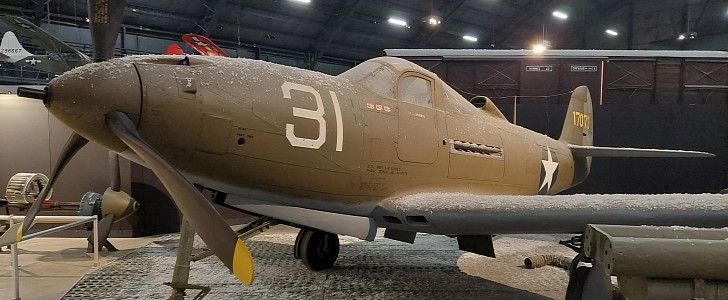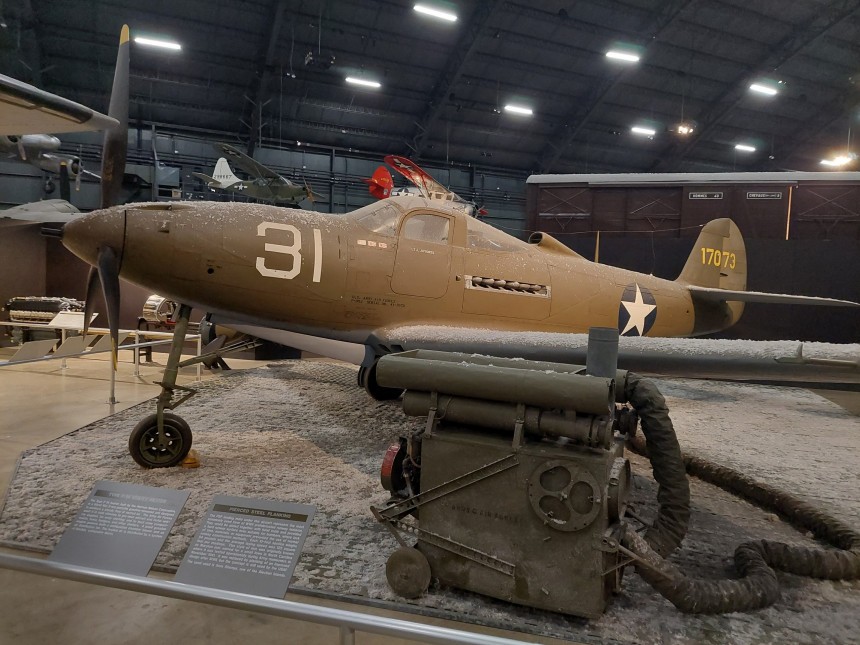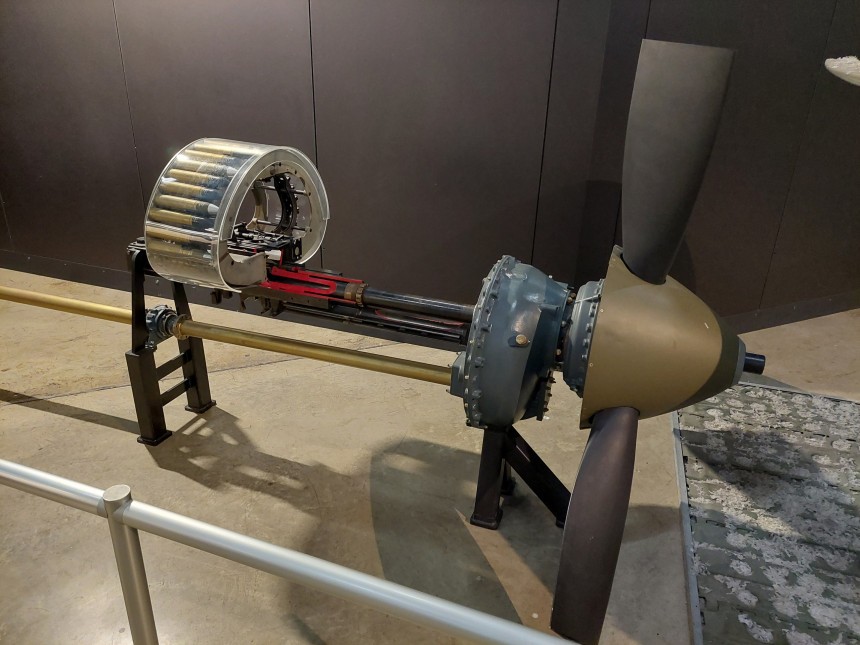Do you want to know why people don't build mid-engined airplanes anymore? It's because it took until after the Second World War for folks to realize mid-engined vehicles don't make practical sense unless they have four wheels and are built by Italians.
Just for a laugh, let's bring you one of the silliest aircraft designs of the war, the Bell P-39 Aerocobra. Bell Aircraft had a bit of a dodgy beginning in its time before it transitioned to helicopter manufacturing full time. How the public viewed the company's aircraft depended on which Air Force you served in.
If you were an American about to be shot to pieces over the Pacific Ocean by Japanese Zeroes, you probably didn't have much to say about it, assuming you lived to tell the story. But if you were a Soviet pilot duking it out with German Bf-109s, you probably had a more favorable opinion.
The failure of the Bell Airocuda didn't help matters. The twin-engined pusher plane had a habit of dumping toxic smoke into the cabin whenever its machine guns were fired. More so, it also had a nasty habit of turning its crew into sausage filling if they tried to bail out in front of the rear-facing propellers.
Bell needed something unique to stay in the good graces of the U.S. Military. Their answer to a request for an Allison V-1710 V12 powered interceptor was a mid-engined single-propeller aircraft with its powerplant mounted behind the cockpit in the middle of the fuselage behind a series of access doors.
Thus was the genesis of the original XP-39. It was to carry a General Electric turbo-supercharging system that would soon be adopted by other aircraft in Allied forces. Unlike in supercars, the primary purpose of mounting the engine middle in such an aircraft was not the weight distribution, like in a Ferrari.
Instead, it was to ensure enough room in the nose section to mount a devastating air-to-air machine cannon. Bell would settle on the 39 mm M4 autocannon for this purpose. The engine was connected to the propeller at the front of the aircraft via a very long driveshaft.
The aircraft was one of the first to employ a tricycle landing gear rather than the traditional tail-sitter configuration. More than enough historic firsts than lots of other aircraft of the period. Ultimately, opinions on the design differed more by country than any other reason. American pilots quickly realized the Airacobra was more or less useless at high altitude dogfighting in the Pacific Theater.
To add to problems, the mid-engined layout meant the Airacobra didn't stall in a deliberate and relatively easy to recover manner. Instead, the engine's weight sitting right in the middle of the airframe would cause it to fall out of the sky in a flat spin like a brick. A pretty horrifying notion when the sky is full of Japanese Zero fighters ready to make you a statistic. The Soviets countered this issue in two ways.
Firstly, by fighting at low to medium altitudes instead of higher ones and not stalling the aircraft in the first place. For every bit of contempt the Americans may have felt towards the P-39, the Soviets equally adored it. Soviet pilots lauded the plane for its impressive medium-altitude performance and its hard-hitting main cannon. It was enough firepower to counter the FW-190 and ME-109 Bf onslaught levied by the German Luftwaffe day after day on the Eastern Front.
Further still, pilots learned that removing the wing-mounted guns made the P-39 just as maneuverable as its German rivals. Over four thousand Airacobras were Lend-Leased to the Soviet Union, many serving until the end of the 1940s. The Airacobra also served with the Italian, Portuguese, and Australian Air Forces during its career. Its most iconic moments came not with American forces but ones abroad.
Today, Airacobras are on display in museums across the globe. But for our money, the very coolest example sits inside the National Museum of the United States Air Force. Here, a P-39Q variant of the Aerocobra is portrayed in a large winter diorama that shows a model ground crew servicing the aircraft with an engine block heater during the time of the Aleutians Campaign in 1942.
During this campaign, the airframe was flown by Lt. Leslie Spoonts of the 57th Fighter Squadron. Displayed next to the aircraft is a true-to-life replica of how an Airacobra drive train and armament system functioned. It's beyond bonkers that such intricate technology was implemented into an airplane that was meant to be built quickly, cheaply, and promptly.
That didn't stop Bell from building nearly ten thousand of them. Most Ferraris don't get made in those numbers, and they claim to be experts in mid-engined designs. Stay tuned for more airplane profiles right here on autoevolution.
.
If you were an American about to be shot to pieces over the Pacific Ocean by Japanese Zeroes, you probably didn't have much to say about it, assuming you lived to tell the story. But if you were a Soviet pilot duking it out with German Bf-109s, you probably had a more favorable opinion.
The failure of the Bell Airocuda didn't help matters. The twin-engined pusher plane had a habit of dumping toxic smoke into the cabin whenever its machine guns were fired. More so, it also had a nasty habit of turning its crew into sausage filling if they tried to bail out in front of the rear-facing propellers.
Bell needed something unique to stay in the good graces of the U.S. Military. Their answer to a request for an Allison V-1710 V12 powered interceptor was a mid-engined single-propeller aircraft with its powerplant mounted behind the cockpit in the middle of the fuselage behind a series of access doors.
Thus was the genesis of the original XP-39. It was to carry a General Electric turbo-supercharging system that would soon be adopted by other aircraft in Allied forces. Unlike in supercars, the primary purpose of mounting the engine middle in such an aircraft was not the weight distribution, like in a Ferrari.
The aircraft was one of the first to employ a tricycle landing gear rather than the traditional tail-sitter configuration. More than enough historic firsts than lots of other aircraft of the period. Ultimately, opinions on the design differed more by country than any other reason. American pilots quickly realized the Airacobra was more or less useless at high altitude dogfighting in the Pacific Theater.
To add to problems, the mid-engined layout meant the Airacobra didn't stall in a deliberate and relatively easy to recover manner. Instead, the engine's weight sitting right in the middle of the airframe would cause it to fall out of the sky in a flat spin like a brick. A pretty horrifying notion when the sky is full of Japanese Zero fighters ready to make you a statistic. The Soviets countered this issue in two ways.
Firstly, by fighting at low to medium altitudes instead of higher ones and not stalling the aircraft in the first place. For every bit of contempt the Americans may have felt towards the P-39, the Soviets equally adored it. Soviet pilots lauded the plane for its impressive medium-altitude performance and its hard-hitting main cannon. It was enough firepower to counter the FW-190 and ME-109 Bf onslaught levied by the German Luftwaffe day after day on the Eastern Front.
Today, Airacobras are on display in museums across the globe. But for our money, the very coolest example sits inside the National Museum of the United States Air Force. Here, a P-39Q variant of the Aerocobra is portrayed in a large winter diorama that shows a model ground crew servicing the aircraft with an engine block heater during the time of the Aleutians Campaign in 1942.
During this campaign, the airframe was flown by Lt. Leslie Spoonts of the 57th Fighter Squadron. Displayed next to the aircraft is a true-to-life replica of how an Airacobra drive train and armament system functioned. It's beyond bonkers that such intricate technology was implemented into an airplane that was meant to be built quickly, cheaply, and promptly.
That didn't stop Bell from building nearly ten thousand of them. Most Ferraris don't get made in those numbers, and they claim to be experts in mid-engined designs. Stay tuned for more airplane profiles right here on autoevolution.
.









